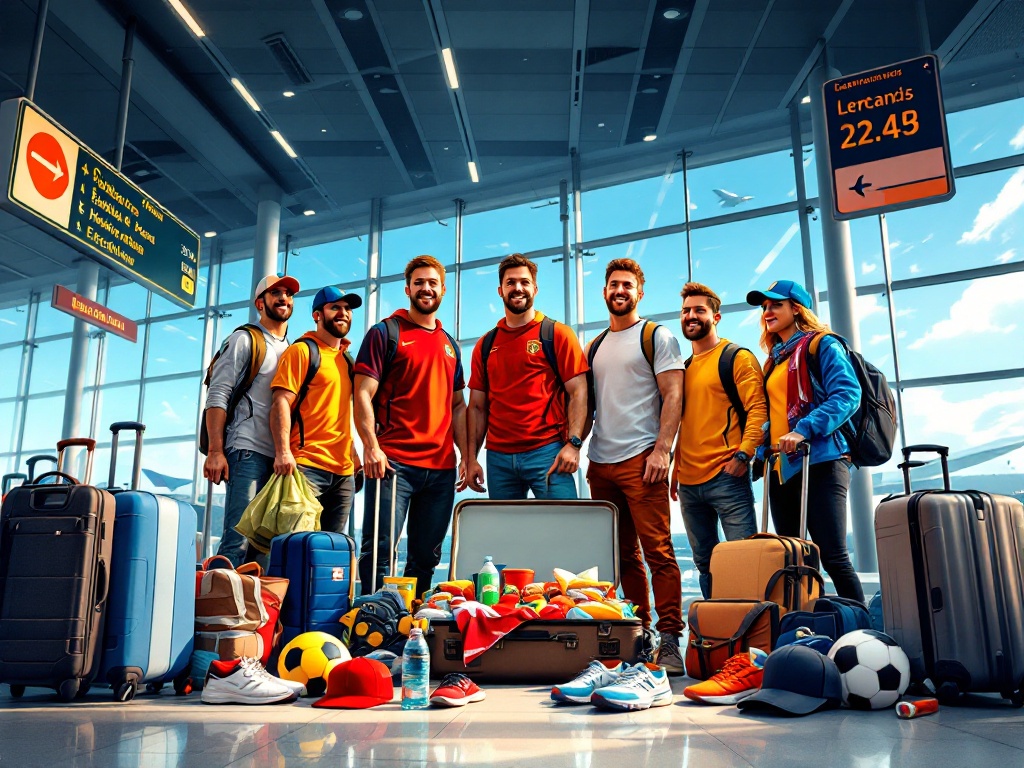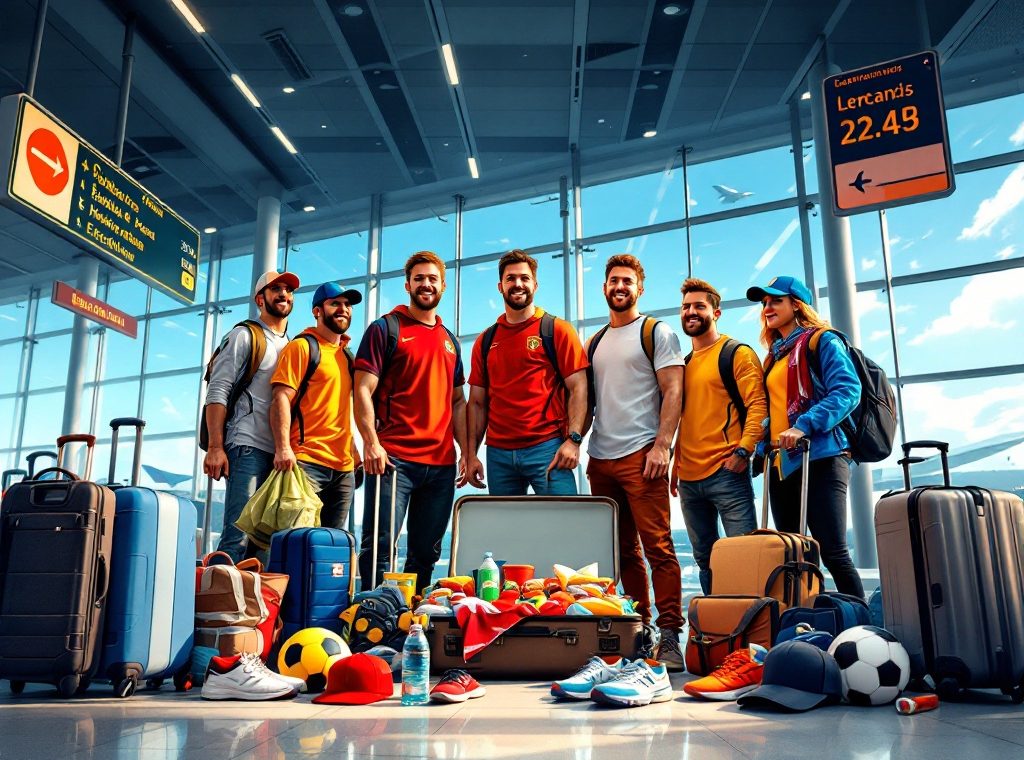Traveling for Sports Events: How to Pack and What to Know
Headed to a big game? Don’t let travel troubles sideline you! This guide covers key steps for smooth sports event travel, from securing vital documents and navigating airline equipment rules to packing essentials and staying fueled. Learn how to book smart, pack efficiently, and ensure your gear arrives safely. Score big with our expert tips for a winning travel experience. Read on to start planning your trip!
Important information

- For international trips, ensure your passport and visa are valid. Check entry rules for your destination.
- Check your airline’s sports equipment policy. Know size and weight limits, plus any fees.
- Book travel and lodging early for better rates. Have backup plans for game day transport.
- Pack uniforms, gear, and regular clothes. Bring a first-aid kit and any needed medications.
- For long events, a cooler with healthy food and drinks is important. Pack snacks for travel.
What to Consider When Traveling for Sports Events
Planning a sporting event trip? Here’s a helpful guide to ensure a smooth and enjoyable experience.
Step 1: Travel Documents
For international travel, ensure your passport and visa are current and valid for your travel dates. Check the specific entry requirements of your destination country well in advance.
Step 2: Airline Regulations
Airlines often have specific rules and fees for transporting sports equipment. Check their guidelines and restrictions on size, weight, and packaging to avoid any surprises at the airport. Consider travel insurance to cover potential damage or loss of your equipment.
Step 3: Book in Advance
Booking your travel and accommodations early can often secure better rates and save you money. Look for deals and discounts on flights and hotels, especially during peak season.
Step 4: Research and Plan
Research the venue’s location and available transportation options. Consider potential traffic, parking, and public transport schedules, especially on game day. Having backup plans for transportation is always a good idea.
Step 5: Venue Policies
Familiarize yourself with the venue’s policies on bags, prohibited items, and security procedures. This will help you avoid any issues or delays upon arrival. Check for any specific rules regarding food, drinks, or cameras.
Understanding Sports Event Travel Requirements
Traveling to a game? If you’re going overseas, make sure your passport is up-to-date. For domestic travel, review the TSA guidelines. Also, check your airline’s specific rules for sporting equipment, which may include size and weight limits or special packaging requirements. Being prepared will ensure a smoother trip.
Exploring Travel Options and Securing Best Rates
Start planning your trip early to save money.
Compare flight prices across different airlines and travel websites.
Look for group discounts and consider alternative transportation like trains or buses.
Book your flights and hotels in advance to secure lower prices.
Importance of Event Registrations and Documentation
Register for the event to secure your spot and confirm your participation.
Prepare thorough documentation, including accommodation confirmations and travel itineraries, for a smooth trip.
Keep both printed and digital copies of your documents readily available to prevent potential problems.
Having digital copies on your phone can be invaluable if your physical documents are lost.
Printed copies offer a reliable backup.
Carry copies of your passport and other essential identification for added security.
Accommodation and Group Travel Arrangements
Team rooms offer significant advantages for team cohesion and organization. They serve as a central hub, providing convenient storage for bags, gear, and personal belongings, minimizing clutter and reducing the risk of lost items. This dedicated space also facilitates team meetings, simplifying scheduling and fostering camaraderie. Additionally, printing confirmations and essential documents in the team room ensures easy access to crucial information, preventing potential delays and confusion upon arrival. These paper copies serve as a reliable backup should electronic devices fail or internet access become limited. Using a team room offers these key benefits:
- Centralized Storage: convenient storage for team members’ belongings, reducing clutter and the risk of lost items.
- Streamlined Meetings: simplifies scheduling and encourages team interaction and bonding.
- Easy Access to Information: readily available printed confirmations and essential documents minimize delays and confusion.
- Reliable Backup: paper copies ensure access to vital information even with technology or connectivity issues.
Booking Team Rooms for Storage and Coordination
Team rooms play a crucial role in sports team dynamics by providing a central hub for several key functions. They offer a secure and organized space for storing equipment, minimizing the risk of loss or misplacement. This centralized storage system promotes order and efficiency, ensuring easy access to necessary gear. Furthermore, team rooms serve as a convenient meeting point, facilitating team gatherings for pre-game discussions, strategy sessions, and other team-building activities. This ease of assembly strengthens communication and fosters a sense of unity, contributing to a more cohesive and collaborative team environment. By providing a dedicated space for these essential functions, team rooms allow athletes to focus on their performance without the distractions of logistical concerns.
Printing Hotel Confirmations and Event Documents
Printed copies offer a reliable backup. Having a physical copy ensures access to your confirmation even if your phone’s battery dies or you encounter internet connectivity issues.
This is especially helpful in areas with unreliable Wi-Fi. Additionally, printed documents can streamline the check-in process for events or other registrations.
Creating a Packing List for Sports Events
Gather all your sportswear, including uniforms, practice attire, and appropriate footwear. Remember specialized gear like gloves, helmets, or pads, depending on your sport.
Pack extra socks and moisture-wicking undergarments for comfort.
Pack everyday clothes suitable for the local climate and your planned activities. Comfortable shoes are essential for travel and downtime.
Don’t forget toiletries, personal hygiene items, and any necessary medications.
A small first-aid kit is a must for minor injuries. Keep travel documents, such as tickets and identification, readily accessible.
Pack a few comfort items like a travel pillow, headphones, or a book to make your trip more enjoyable.
Essential Packing Items for Athletes
Packing for athletic events requires careful consideration of essential gear. Be sure to pack your uniforms and appropriate footwear for your sport. Remember to include any sport-specific equipment you’ll need, such as bats, gloves, or rackets. Don’t forget personal items like toiletries, chargers, and any necessary medications. A first-aid kit is crucial for addressing unexpected injuries or ailments. Pack snacks to maintain energy levels and sunscreen to protect yourself from the sun’s harmful rays.
Preparing Personal Items and Clothing
- When packing, bring at least three shirts and two pairs of pants or shorts.
- Opt for comfortable clothing suitable for various weather conditions.
- Remember your toiletries and personal care items.
Incorporating Travel Essentials and Comfort Items
Pack these essentials for a comfortable tournament day: a cooler for chilled snacks and drinks, bug spray, a fold-out chair, and a first-aid kit for minor injuries. Enjoy the tournament!
Essential Sporting Equipment and Gear
Pack a uniform for each game, accounting for potential damage or laundry delays. Use garment bags to protect your uniforms and keep them wrinkle-free. Pack smaller items like socks and accessories in separate, labeled bags within your sports bag.
Research airline regulations for sports equipment before traveling, as size and weight limits, fees, and notification requirements vary. This includes specific rules for items like bats, golf clubs, and skis.
Protect your equipment using sturdy, padded travel cases designed specifically for sports gear. Label everything clearly with your name, contact information, and destination address. Add TSA-approved locks for extra security. If possible, carry essential or irreplaceable equipment in your carry-on luggage.
Packing Uniforms and Competition Gear
Pack your uniforms and competition gear in a separate bag to keep them organized and safe.
Use packing cubes or small bags inside the main bag to help you locate items quickly.
Consider using protective cases for fragile gear to provide added protection.
Label all equipment with your contact information in case anything gets misplaced.
Understanding Airline Rules for Sporting Equipment
Traveling with sports equipment can be hassle-free with a little planning. Before you go, check your airline’s size and weight restrictions to avoid unexpected fees and baggage issues. Protect your valuable gear by using hard cases for fragile items like skis, golf clubs, and racquets. Durable bags are recommended for other equipment. Clearly label everything with your contact information in case your bag gets lost.
Tips for Easier Travel with Sports Equipment
- Check airline’s size and weight restrictions,
- Use hard cases for fragile items,
- Use durable bags for other equipment,
- Label everything with your contact information.
Additional Considerations
- For larger/heavier items, consider shipping to your destination,
- Keep essential personal gear in your carry-on,
- Double-check venue rules to ensure your equipment is permitted.
How to Ensure Equipment Arrives Safely
Protect your sports equipment using durable, padded bags or cases specifically designed for athletic gear.
Consult your airline’s size and weight restrictions for luggage.
Label all your equipment with your contact information.
Consider shipping large or bulky items to your destination to simplify travel.
Pack essential gear in your carry-on bag to ensure you have it if your checked luggage is delayed.
Explore the option of renting equipment at your destination to avoid transport hassles.
Check the venue’s rules and regulations to ensure your sports equipment is permitted.
Planning Food and Nutrition for Sports Travel
Fuel your game with smart snacking. For quick energy boosts, pre-pack portable, non-perishable options like nuts, seeds, and dried fruit. For sustained energy, consider energy bars, whole-grain crackers, or fresh fruit. Remember to choose snacks you enjoy and that meet your dietary needs.
Snacks
- Nuts,
- Seeds,
- Dried fruit.
For sustained energy
- Energy bars,
- Whole-grain crackers,
- Fresh fruit.
For extended tournaments, a cooler is a must-have. It keeps perishables like sandwiches, salads, yogurt, and fruit fresh throughout the day. Pack reusable ice packs and a refillable water bottle to stay hydrated. A cooler bag ensures food safety and provides easy access to healthy meals and snacks, keeping you fueled and focused all day long.
Importance of Snacks for the Journey
- For convenient, nutritious snacks, athletes can choose energy bars, portable fruits like bananas and apples, nuts, and yogurt.
- These snacks help maintain energy levels, especially during travel and between games, allowing athletes to perform at their peak.
- Nuts and yogurt provide sustained energy for optimal performance.
Using a Cooler for Long Tournament Days
For long tournaments, coolers are essential for maintaining the optimal temperature of food and drinks, which helps athletes stay hydrated and energized. Access to refreshing beverages and snacks can significantly boost focus and performance. Pack wisely with items like water, sports drinks, sandwiches, fruit, and yogurt.
Safety and Comfort During Sports Events
Pack a first aid kit for minor injuries like cuts, sprains, and blisters, especially for sporting events. Foldable chairs and travel pillows can also greatly increase comfort during long events, providing much-needed rest and support.
Benefits of a First Aid Kit for Minor Injuries
A well-stocked first aid kit is essential for athletes to address minor injuries like cuts, sprains, and blisters. Prompt treatment can prevent infections and promote faster healing, allowing a quick return to action. Having a readily available kit also minimizes the need for outside medical assistance, which is especially beneficial during sporting events.
Comfort Essentials: Fold Out Chairs and Travel Pillows
Fold-out chairs provide comfortable seating, perfect for extended breaks between games or while traveling. Travel pillows offer crucial neck and head support, promoting relaxation and better sleep on the go. Both items encourage rest and recovery, helping athletes conserve energy and enhance their performance.


















